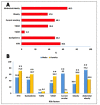Prevalence of atherosclerosis risk factors in Egyptian patients with acute coronary syndrome: final data of the nationwide cross-sectional 'CardioRisk' project
- PMID: 33623654
- PMCID: PMC7893316
- DOI: 10.4081/jphia.2020.1368
Prevalence of atherosclerosis risk factors in Egyptian patients with acute coronary syndrome: final data of the nationwide cross-sectional 'CardioRisk' project
Abstract
Background: Little are known about the prevalence of atherosclerosis risk factors in Egyptian patients with acute coronary syndromes (ACS).
Objective: Describe the prevalence of these risk factors with focus on gender-specific data and patients with premature presentation.
Methods: From November 2015 to August 2018, data were collected from 3224 patients with ACS in 30 coronary care centers covering 11 governorates across Egypt, with focus premature ACS.
Results: The vast majority were males (74%) and the most prevalent age group was (56-65 years) representing 37% of whole study population. Among female patients, 92% were post-menopausal. The prevalence of premature ACS was 51%. Forty five percent of total males and 69.6% of total females with ACS had premature presentation (P<0.001). Abdominal obesity was the most prevalent risk factor (66%). Nearly half of the entire study patients were current smokers (48%). We showed a high prevalence of documented dyslipidemia (48%) as well. Early invasive management strategy was employed in 65% of patients with no significant gender disparity noticed. Vascular access for coronary angiography was most commonly femoral (80% of time). Emergent percutaneous coronary intervention (PCI) was attempted in 53% of patients. Thrombolytic therapy (using Streptokinase) was used in 24% of included participants.
Conclusion: Among Egyptian patients with ACS, premature presentation is common with greater male preponderance. Abdominal obesity is the most prevalent risk factor followed by hypertension. Most traditional risk factors (apart from smoking) were more prevalent in women than men.
Keywords: Acute coronary syndrome; Egypt; Risk factors.
©Copyright: the Author(s).
Conflict of interest statement
Conflict of interest: The authors declare no potential conflict of interest.
Figures


Similar articles
-
The pattern of risk-factor profile in Egyptian patients with acute coronary syndrome: phase II of the Egyptian cross-sectional CardioRisk project.Cardiovasc J Afr. 2019 Mar/Apr 23;30(2):87-94. doi: 10.5830/CVJA-2018-074. Epub 2019 Jan 16. Cardiovasc J Afr. 2019. PMID: 30720847
-
Smoking and Provision of Smoking Cessation Interventions among Inpatients with Acute Coronary Syndrome in China: Findings from the Improving Care for Cardiovascular Disease in China-Acute Coronary Syndrome Project.Glob Heart. 2020 Oct 23;15(1):72. doi: 10.5334/gh.784. Glob Heart. 2020. PMID: 33150137 Free PMC article.
-
Prevalence and impact of cardiovascular risk factors among patients presenting with acute coronary syndrome in the middle East.Clin Cardiol. 2011 Jan;34(1):51-8. doi: 10.1002/clc.20873. Clin Cardiol. 2011. PMID: 21259279 Free PMC article.
-
API expert consensus document on management of ischemic heart disease.J Assoc Physicians India. 2006 Jun;54:469-80. J Assoc Physicians India. 2006. PMID: 16909697 Review.
-
Transradial versus transfemoral percutaneous coronary intervention in acute coronary syndromes: re-evaluation of the current body of evidence.JACC Cardiovasc Interv. 2013 Nov;6(11):1149-52. doi: 10.1016/j.jcin.2013.08.003. JACC Cardiovasc Interv. 2013. PMID: 24262614 Review.
Cited by
-
The Egyptian Association of Vascular Biology and Atherosclerosis (EAVA) Perspectives on the Usage of Inclisiran.Cardiol Ther. 2022 Dec;11(4):461-471. doi: 10.1007/s40119-022-00277-3. Epub 2022 Sep 2. Cardiol Ther. 2022. PMID: 36053454 Free PMC article.
-
Association Between Perceived Control and Acute Coronary Syndrome Symptom Severity: A Prospective Cohort Study.Nurs Open. 2025 Mar;12(3):e70181. doi: 10.1002/nop2.70181. Nurs Open. 2025. PMID: 40084773 Free PMC article.
-
The Pandemic of Coronary Heart Disease in the Middle East and North Africa: What Clinicians Need to Know.Curr Atheroscler Rep. 2023 Sep;25(9):543-557. doi: 10.1007/s11883-023-01126-x. Epub 2023 Aug 24. Curr Atheroscler Rep. 2023. PMID: 37615785 Free PMC article. Review.
-
Clinical and angiographic profile of left main coronary artery disease in patients with chronic coronary syndrome: a retrospective study.Egypt Heart J. 2025 Feb 3;77(1):17. doi: 10.1186/s43044-025-00615-5. Egypt Heart J. 2025. PMID: 39899226 Free PMC article.
-
2024 Egyptian consensus statement on the role of non-statin therapies for LDL cholesterol lowering in different patient risk categories.Egypt Heart J. 2024 Sep 20;76(1):131. doi: 10.1186/s43044-024-00562-7. Egypt Heart J. 2024. PMID: 39302613 Free PMC article. Review.
References
-
- Stanaway JD, Afshin A, Gakidou E, et al. Global, regional, and national comparative risk assessment of 84 behavioural, environmental and occupational, and metabolic risks or clusters of risks for 195 countries and territories, 1990– 2017: a systematic analysis for the Global Burden of Disease Study 2017. The Lancet 2018;392:1923-94. - PMC - PubMed
-
- Yusuf S, Hawken S, Ounpuu S, et al. Effect of potentially modifiable risk factors associated with myocardial infarction in 52 countries (the INTERHEART study): case-control study. Lancet 2004;364:937-52. - PubMed
-
- Roth GA, Huffman MD, Moran AE, et al. Global and regional patterns in cardiovascular mortality from 1990 to 2013. Circulation 2015;132:1667-78. - PubMed
-
- Yusuf S, Reddy S, Ounpuu S, Anand S. Global burden of cardiovascular diseases: part I: general considerations, the epidemiologic transition, risk factors, and impact of urbanization. Circulation 2001;104: 2746-53. - PubMed
LinkOut - more resources
Full Text Sources
Other Literature Sources
Miscellaneous
